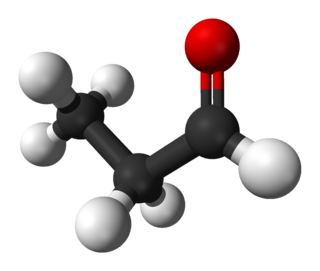
In organic chemistry, an imine is a functional group or organic compound containing a carbon–nitrogen double bond. The nitrogen atom can be attached to a hydrogen or an organic group (R). The carbon atom has two additional single bonds. Imines are common in synthetic and naturally occurring compounds and they participate in many reactions.

In organic chemistry, a methoxy group is the functional group consisting of a methyl group bound to oxygen. This alkoxy group has the formula R−O−CH3.
The Gabriel synthesis is a chemical reaction that transforms primary alkyl halides into primary amines. Traditionally, the reaction uses potassium phthalimide. The reaction is named after the German chemist Siegmund Gabriel.
The Ullmann condensation or Ullmann-type reaction is the copper-promoted conversion of aryl halides to aryl ethers, aryl thioethers, aryl nitriles, and aryl amines. These reactions are examples of cross-coupling reactions.
The Vilsmeier–Haack reaction (also called the Vilsmeier reaction) is the chemical reaction of a substituted formamide (1) with phosphorus oxychloride and an electron-rich arene (3) to produce an aryl aldehyde or ketone (5):

In organic chemistry, an iminium cation is a polyatomic ion with the general structure [R1R2C=NR3R4]+. They are common in synthetic chemistry and biology.

2,2-Dimethoxypropane (DMP) is an organic compound with the formula (CH3)2C(OCH3)2. A colorless liquid, it is the product of the condensation of acetone and methanol. DMP is used as a water scavenger in water-sensitive reactions. Upon acid-catalyzed reaction, DMP reacts quantitatively with water to form acetone and methanol. This property can be used to accurately determine the amount of water in a sample, alternatively to the Karl Fischer method.

Crotonaldehyde is a chemical compound with the formula CH3CH=CHCHO. The compound is usually sold as a mixture of the E- and Z-isomers, which differ with respect to the relative position of the methyl and formyl groups. The E-isomer is more common (data given in Table is for the E-isomer). This lachrymatory liquid is moderately soluble in water and miscible in organic solvents. As an unsaturated aldehyde, crotonaldehyde is a versatile intermediate in organic synthesis. It occurs in a variety of foodstuffs, e.g. soybean oils.
The reduction of nitro compounds are chemical reactions of wide interest in organic chemistry. The conversion can be effected by many reagents. The nitro group was one of the first functional groups to be reduced. Alkyl and aryl nitro compounds behave differently. Most useful is the reduction of aryl nitro compounds.
The Béchamp reduction is a chemical reaction that converts aromatic nitro compounds to their corresponding anilines using iron as the reductant:
Flash vacuum pyrolysis (FVP) is a technique in organic synthesis. It entails heating a precursor molecule intensely and briefly. Two key parameters are the temperature and duration, which are adjusted to optimize yield, conversion, and avoidance of intractable products. Often the experiment entails volatilizing a precursor, which is drawn through a "hot zone" followed by rapid condensation. The apparatus typically is conducted under dynamic vacuum. The hot zone must impart heat to the gaseous molecules, so it is generally packed with solids to induce gas-solid collisions. The packing material is generally chemically inert, such as quartz. The precursor (i) volatilizes with gentle heating and under vacuum, (ii) the precursor fragments or rearranges in the hot zone, and finally (iii) the products are collected by rapid cooling. Rapid post-reaction cooling and the dilution inherent in gases both suppress bimolecular degradation pathways.
Aminoaldehydes and aminoketones are organic compounds that contain an amine functional group as well as either a aldehyde or ketone functional group. These compounds are important in biology and in chemical synthesis. Because of their bifunctional nature, they have attracted much attention from chemists.
2-Cyclopentenone is the organic compound with the chemical formula (CH2)2(CH)2CO. 2-Cyclopentenone contains two functional groups, a ketone and an alkene. It is a colorless liquid. Its isomer, 3-cyclopentenone is less commonly encountered.

Propionaldehyde or propanal is the organic compound with the formula CH3CH2CHO. It is the 3-carbon aldehyde. It is a colourless, flammable liquid with a pungent and fruity odour. It is produced on a large scale industrially.
In organic chemistry, ketonic decarboxylation is a type of organic reaction and a decarboxylation converting two equivalents of a carboxylic acid to a symmetric ketone by the application of heat. It can be thought of as a decarboxylative Claisen condensation of two identical molecules. Water and carbon dioxide are byproducts:

Diethyl chlorophosphate is an organophosphorus compound with the formula (C2H5O)2P(O)Cl. As a reagent in organic synthesis, it is used to convert alcohols to the corresponding diethylphosphate esters. It is a colorless liquid with a fruity odor. It is a corrosive, and as a cholinesterase inhibitor, highly toxic through dermal absorption. The molecule is tetrahedral.

In chemistry, ureas are a class of organic compounds with the formula (R2N)2CO where R = H, alkyl, aryl, etc. Thus, in addition to describing the specific chemical compound urea ((H2N)2CO), urea is the name of a functional group that is found in many compounds and materials of both practical and theoretical interest. Generally ureas are colorless crystalline solids, which, owing to the presence of fewer hydrogen bonds, exhibit melting points lower than that of urea itself.

Propionyl chloride (also propanoyl chloride) is the organic compound with the formula CH3CH2C(O)Cl. It is the acyl chloride derivative of propionic acid. It undergoes the characteristic reactions of acyl chlorides. It is a colorless, corrosive, volatile liquid.

2-Methylbenzaldehyde is an organic compound with the formula CH3C6H4CHO. It is a colorless liquid.

tert-Butyl hypochlorite is the organic compound with the formula (CH3)3COCl. A yellow liquid, it is a rare example of an organic hypochlorite, i.e. a compound with an O-Cl bond. It is a reactive material that is useful for chlorinations. It can be viewed as a lipophilic version of sodium hypochlorite (bleach).













